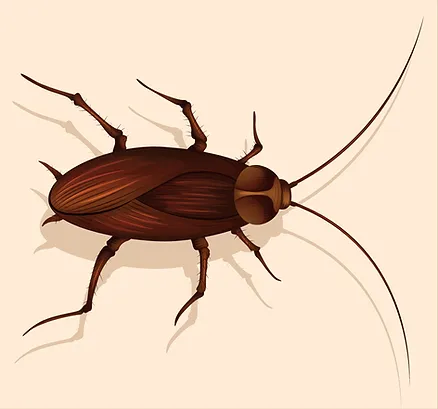Cockroaches are among the most common pests on earth. As a result, they are present in homes, offices, restaurants, stores, factories, and a range of other buildings.
Cockroaches are pests for which most homeowners and business owners seek pest control services at their premises.
Though cockroach control has evolved from pesticide emulsions (sprays) to solid gel bait, cockroaches are not easy pests to control. They have developed inheritable resistance to liquid pesticides and gel and continue challenging human efforts to control them.
This article shares a list of fifty quirky cockroach facts that help you understand it better. We are sure that by reading this list, you will appreciate the cockroach’s different aspects, making it a formidable pest.

1. How long can a cockroach live without food?
As they are cold-blooded animals, cockroaches can survive without eating food for one month.
2. How many species of cockroaches exist on earth?
There are about four thousand six hundred cockroach species on earth. However, we may encounter only the common four species, the German cockroach, the American cockroach, the oriental cockroach, and the brown-banded cockroach, at our homes.
3. How many cockroach species are associated with human habitats?
Only 30 of the approximately 4600 cockroach species on earth are found in the vicinity of human habitats.
4. Do cockroaches like alcohol?
Cockroaches prefer fermented foods, including alcohol. The common alcoholic beverage beer attracts cockroaches.
5. How fast can cockroaches move?
Cockroaches can be fast, moving at nearly five kilometers an hour.
6. Is it true that cockroaches can hold their breath?
Yes. Cockroaches regulate their body’s water content through respiration. As a result, they can survive underwater for nearly half an hour, during which they hold their breath.
7. How does a cockroach survive for a week without a head?
As cockroaches breathe through spiracles or small openings in their body, they don’t need a head or mouth to breathe. As a result, cockroaches die without a head as they can’t consume water and thus die from dehydration when they lose their head.
8. How long have cockroaches lived on earth?
Cockroaches had lived on earth for more than 350 million years and were here when dinosaurs roamed the earth.
9. How do cockroaches cause respiratory illnesses?
People with asthma can be sensitive to cockroaches as the proteins from the latter can trigger allergic reactions. In addition, cockroach droppings and their exoskeletons which they shed during molting, trigger allergic reactions in people.
10. Do all cockroaches fly?
No. A few cockroach species fly, but a few other species can only be airborne and flutter their wings which may appear as flying. Most cockroach species cannot fly.
11. Will a clean home prevent cockroaches?
No. A clean home, too, can have a cockroach infestation that may originate from the neighbors or through entry points into the home. Cockroaches look for food and water at homes and enter even clean homes looking for those.
12. Are cockroaches omnivores?
Yes, cockroaches eat various foods, including food that humans consume, dead cockroaches, and plant materials. They also consume paper, glue in binding, starch, fruit, leather, skin flakes, cork, grass, hair, dead insects, and soiled clothing.
13. What is the longevity of cockroaches?
Depending on their species, cockroaches may live from a few months to a few years.
14. Is there any place on earth where you can’t find cockroaches?
Yes. Antarctica. As cockroaches are adapted to living with humans, cockroaches occur on all continents except Antarctica.
15. How do cockroaches find each other?
Cockroaches secrete an aggregation pheromone or a chemical scent with which they communicate with other species. In addition, cockroaches excrete pheromones in their feces which helps other cockroaches to find food and water, leading to a congregation of cockroaches that appear like a swarm of them.
16. What is the most common cockroach activity?
Cockroaches spend three-quarters of their time resting!
17. What is the lowest temperature that cockroaches can endure?
Cockroaches can tolerate temperatures as low as 32 F or 0C.
18. Is it true that people eat cockroaches?
People in Thailand, Mexico, China, and Taiwan eat cockroaches. Cockroach farms mass-produce insects for culinary use. In addition, traditional Chinese medicine relies on cockroaches for curing different illnesses.
19. What is the origin of the word cockroach?
The word cockroach originates from the Spanish Cucaracha, which slowly transformed into the English word cockroach in the seventeenth century.
20. To which insects are cockroaches closely related?
Cockroaches are part of the insect superorder, Dictyoptera, and are closely related to termites and mantids.
21. How does a cockroach repel water?
The cockroach exoskeleton has wax and is hydrophobic, thereby repelling water.
22. Which is the world’s heaviest cockroach?
The Australian giant burrowing cockroach Macropanesthia rhinoceros can weigh up to 35 grams. The Central American giant cockroach Blaberus giganteus also can grow to a similar weight as the Australian giant burrowing cockroach.
23. What is special about cockroach wings?
The cockroach’s external wings, or the tegmina, are tough and protect the membranous inner wings which the cockroach uses in flying.
24. How do cockroaches decide where to go?
Cockroaches decide to move based on the level of darkness and the number of other cockroaches present.
25. What is the mystery behind white cockroaches?
A transient stage of cockroaches is when they emerge from eggs while molting when they are white. However, cockroaches turn darker in a few hours after emerging from eggs or after molting, disproving the existence of white or albino cockroaches.
26. Is it true that cockroaches will survive a nuclear war?
It is partly true that cockroaches are many times more resistant to nuclear radiation than humans and other vertebrates.
27. What is the fear of cockroaches called?
Katsaridaphobia or cockroach phobia is the fear of cockroaches.
28. What is the reason behind the smell of a squished cockroach?
Cockroaches store nitrogenous wastes like uric acid in their fat for recycling, and the malodor from a squished cockroach originates from that uric acid.
29. What is glucose aversion?
It is the behavior of cockroaches to avoid cockroach gel baits containing glucose. As a result, gel baits containing glucose are ineffective in controlling German cockroaches with glucose aversion.
30. Why do you call cockroaches thigmotactic?
Thigmotaxis is a creature’s response to the stimulus of contact or touch. Cockroaches are positively thigmotactic, seek contact with other objects, and squeeze into cracks and crevices by the preference for congested spaces. Due to such cockroach behavior, it is very difficult to control them as they can hide in places where pesticides or other treatments don’t affect them.
31. How can you use thigmotaxis against cockroaches?
Cockroach traps mimic thigmotaxis and make cockroaches crawl in by mimicking tight spaces that the insect prefers. Unfortunately, cockroaches entering cockroach traps get stuck to the glue in them.
32. Where did the American cockroach (Periplaneta americana) originate?
The American cockroach is native to Africa and the Middle East.
33. How long do American cockroaches live?
American cockroaches can live up to one and a half years.
34. What is the symbiotic relationship between cockroaches and bacteria?
Cockroaches have bacteria called Bacteroides in special cells called mycetocytes where the bacteria produce vitamins and amino acids for their hosts.
35. What is the widest wingspan of a cockroach species?
The Megaloblatta longipennis found in south and central America can have a wingspan of up to 22 cm.
36. Can you train cockroaches?
Yes, two Japanese scientists trained cockroaches to respond to food flavors when followed by a sugary treat.
37. What are the ideal conditions for German cockroaches?
German cockroaches love heat and humidity, preferring temperatures of 85 to 95 F and relative humidity of 90 to 95%.
38. Can insecticides kill the eggs in a German cockroach egg case?
No. The German cockroach’s egg capsule is not susceptible to insecticides.
39. What is insecticide resistance in German cockroaches?
Insecticide resistance is the phenomenon by which the least susceptible members of a German cockroach population that survive an insecticide treatment pass on their resistance to their progeny.
40. What are some sounds that cockroaches make?
The Madagascar hissing cockroach (Gromphadorhina portentosa) makes a hissing sound while ejecting air from its spiracles or breathing holes to convey courtship, aggression, or disturbance.
41. How do cockroaches survive unsanitary conditions?
They have a strong immune system that can kill microbes and remain safe.
42. Why are cockroaches, impressive weightlifters?
Cockroaches can withstand weights up to 900 times their body weights.
43. Does anyone keep cockroaches as pets?
Yes, the Madagascar hissing cockroach is a popular pet.
44. Do cockroaches produce milk?
The cockroach species, Diploptera punctata produces nutrient-rich crystals that contain carbohydrates, proteins, and fats.
45. Which animals feed on cockroaches?
Spiders, centipedes, scorpions, wasps, birds, reptiles, and mammals feed on cockroaches.
46. How much can cockroaches remember?
Not a lot, as they start each day without remembering what happened the previous day.
47. How many offspring can a cockroach produce at a time?
A female cockroach can produce 400 baby cockroaches at a time.
48. What is the ecological role of cockroaches?
*Cockroaches are decomposers or saprophytes that feed on decaying organic matter and help in nutrient cycling in an ecosystem.
49. What is special about the receptors in American cockroaches
The American cockroaches have 154 olfactory and 544 gustatory receptors making them masters of smelling and testing food among all insects.
50. What are Cytochrome P450 genes in cockroaches
They are a bunch of genes that encode detoxification enzymes and keep cockroaches safe from peppermint and other toxins.







